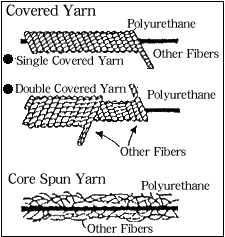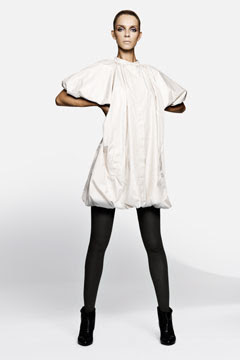
I do not have a name for it yet, but it is about repetition of physical things. i got this idea because i realized PREEN base their designs in a lot in pleating and folding. so i came out with this.
 I chose several garments from net a porter one of PREEN’s stockists, each of them are made from different materials, so I am analysing all the fabric to know the history as well as the fabrication method.
I chose several garments from net a porter one of PREEN’s stockists, each of them are made from different materials, so I am analysing all the fabric to know the history as well as the fabrication method. This dress is made out of three different fabrics this is:
Acetate
This has been used for the inside of the dress, lining.
This fibre was created by two Swiss brothers in 1905.
Cellulose acetate or acetate rayon fibred is one of the earliest synthetic fibers and is based on cotton or tree pulp cellulose.
These "cellulosic fibres" have passed their peak as cheap petro-based fibers (nylon and polyester) and have displaced regenerated pulp fibres.
Information taken from:
http://www.apparelsearch.com/Definitions/Fiber/acetate_definition.htm
Polyurethane fibre is highly stretch and elastic as rubber, strong than rubber, and resistant to aging. The fibre is dyeable freely and fine yarn can be produced.
Polyurethane fibre is manufactured from glycol and disocyanate as raw material with a special spinning method.
No product is manufactured of 100% poly-urethane fiber. The polyurethane fiber is used by blending other fibers. A fabric, referred to "two-way tricot" in which a polyurethan fiber is knitted with a nylon or polyester filament yarn, is highly elastic both in wale- and course-way and is used for swimsuits, leotards, underwear and other similar stretchable clothing.
This fiber is use as part of foundations as Brassieres, Girdles, Corsets, Sweaters, Underwear, Pantyhose, Socks, Swimsuits, Shirts Slacks.
Characteristics:


This fibre is manufactured in countries such as:
-
-
-Singapore
-Canada
-Malaysia
-USA
-Chile
-UAE
-
-
Carpenter Limited
Unit 1, Dinting Lodge Industrial Estate, Dinting Vale
Glossop - SK136LE
+(44)-(1457)-861141
This fibre was use to make the dress thicker and make it stand better, it is place between the lining and the elastane.
Elastane
 This fibre is best known as Lycra and Dorlastan.
This fibre is best known as Lycra and Dorlastan.
It was invented
This fibre is made out of petroleum, for that reason some people are allergic to it.
Fabrication:
There two fabrication methods:
1- Wrap the elastane fibre in a non-elastic thread - either natural or man-made. The resulting yarn has the appearance and feel of the outer fibre used.
2- Using pure elastane threads, which are worked or woven into fabrics made from other fibres. The added elasticity makes such fabrics more comfortable to wear. Blends with elastane depend on the type of fabric and the end use.
Characteristics:
· Compared to rubber, elastane has both greater tear resistance and durability and a tension capacity two or three times greater, at a third of the weight.
· When stretched, it always reverts to its original form
· Elastane is used in all areas where a high degree of permanent elasticity is required
· Is a prerequisite for fashionable or functional apparel which is intended to
Cling to the body, while at the same time remaining comfortable.
· Two per cent elastane is enough to make trousers, for instance, retain their shape. For body-shaped silhouette and high stretch capacity, i.e. in swimwear, corsetry or sportswear, 15 - 40% elastane is used.
· Elastane fibres guarantee a high degree of comfort combined with great freedom of movement.
· In woven and knitted fabrics elastane increases shape retention and accelerates crease recovery.
· Elastane is not sensitive to transpiration, make-up, cosmetics, sun cream or sea water. For example swimwear with elastane should be rinsed out after bathing.
· Elastane is easy to care for.
Information taken from:
http://www.ivc-ev.de/live/index.php?page_id=73


This garment is made out of three fibres
Acrylic is another man-made fibre where development in
Acrylic fabric is used widely in knits, as upholstery covering, and the fibers may be woven to make rugs. People often think of acrylic fabric as an excellent wool substitute, and certain forms of it are exceptionally soft, while remaining lightweight. Certain cashmere substitutes are made with acrylic fabric and are considered as good or better than cashmere in softness and appearance. Some woven garments may contain an acrylic blend with natural fibers.
Fabrication:

Characteristics:
· 75 % of acrylic fibres are used in apparel in jumpers, waistcoats, cardigans, jackets, socks, knee-high stockings, training and jogging suits, either pure or in blends for example with wool.
· 20% in home furnishing
· 5% in industrial end-uses.
· Feels like wool, with high bulk.
· Very good heat retention and fastness to light.
· Very good shape retention, durability, easy care and quick dry qualities.
· Qualities such as its wool-like feel and bulk make it pre-destined for use in the knitwear sector.
· The positive features of acrylic fibres come into their own when they are blended with a suitable proportion of wool or other natural fibres:
· the wool needs practically no additional finishing, does not felt when washed and is significantly easier to care for.
· With sportswear, training and jogging suits particularly benefit from the special advantages of acrylic fibres - be it pure or blended: low water absorption, quicker water transport, light and weather resistance.
http://www.ivc-ev.de/live/index.php?page_id=71





.jpg)















 And here is when some of my inspiration started to come out....looking at the ribbons i can see the repetition on shapes , styles...
And here is when some of my inspiration started to come out....looking at the ribbons i can see the repetition on shapes , styles...



I have been following my designer and my research since the Brief was handed in the beginning of January, but it has been over a word document as a PDP. So following my PDP I’ll update you with all iv been doing in this past month.
The designer I have been assigned is PREEN, many of you probably think, who? What? that’s what I thought....so real quick I started exploring this fantastic label...and I came up with two creators/ designers...Justin Thornton and Thea Bregazzi....for that they call the label "PREEN by Thornton Bregazzi"

So i had a little look through their collections which they show on their website....
From Past - Present - Future:
They choose pastel colours for the summer collections and dark colours for winter.
In this last winter collection
Looking at several collections, I have determined that loose fit is the Key style for PREEN's designs which I think is fabulous , as it never has the boring fit, Thornton Bregazzi decided to use, pleats, gathers, open back
s, ruffles....everything to make an interesting shape to the garment!!!
The clothes look elegant at the same young and rocky….

As well as that they have added a manly kind of styli which makes me think, that they might have taken ideas from a military style.
1 Decade of Ideas
The book has 72 pages, and we can see 9 of them on the website, which is like giving a sweet to a child and then taken it from him/ her as the book looks really interesting, but it cost £40 and I am still thinking if its worth it or not.






